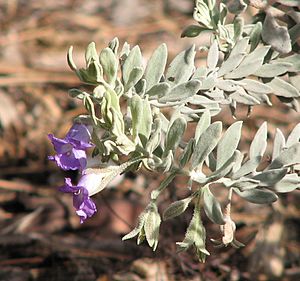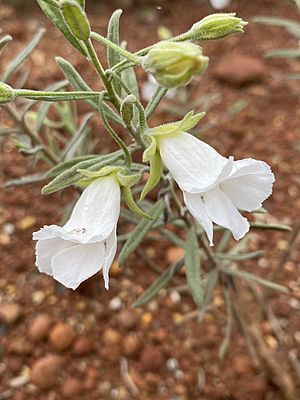Silver turkeybush facts for kids
Quick facts for kids Silver turkeybush |
|
|---|---|
 |
|
| Eremophila bowmanii subsp. latifolia in the Royal Botanic Gardens, Melbourne | |
| Scientific classification | |
| Genus: |
Eremophila (plant)
|
| Species: |
bowmanii
|
| Synonyms | |
|
|

The Silver Turkeybush (Eremophila bowmanii) is a cool flowering plant found only in parts of New South Wales and Queensland, Australia. It's also known by names like Bowman's poverty bush or flannel bush. This plant is a low to medium-sized shrub with unique silvery-grey, hairy leaves and pretty blue or lilac flowers. Sometimes, it grows in thick groups alongside Mulga trees.
Contents
What Does It Look Like?
The Silver Turkeybush is usually a shrub that grows about 1.5 m (5 ft) tall and wide. But it can sometimes reach up to 3 m (10 ft)! Its branches, leaves, and even the parts around its flowers are covered in tangled, silvery hairs. This makes the whole plant look silvery-grey.
Its leaves are usually between 9 mm (0.4 in) and 50 mm (2 in) long. They can be thin and long, or shaped like an egg, or even almost round.
Its Flowers
The flowers usually grow one by one where the leaves meet the stem. Each flower sits on a stalk about 6 mm (0.2 in) to 19 mm (0.7 in) long. Before the petals open, there are 5 pointed, green to purple leaf-like parts called sepals. These sepals are 12 mm (0.5 in) to 19 mm (0.7 in) long and are also covered in silvery hairs.
The petals are about 21 mm (0.8 in) to 30 mm (1 in) long. They join together at the bottom to form a tube. This tube is usually purple or lilac, but sometimes it can be white. You might even see small purple spots inside the tube! The outside of the tube and the petal tips are mostly smooth, but the inside of the tube is woolly. There are four stamens (the parts that make pollen) hidden inside the petal tube.
Silver Turkeybush flowers mostly from winter to late spring. After the flowers, it grows oval-shaped fruits. These fruits are 6 mm (0.2 in) to 8.5 mm (0.3 in) long, woody, and have a papery covering.
How It Got Its Name
This plant was first officially described in 1861 by a famous botanist named Ferdinand von Mueller. He wrote about it in his book Fragmenta Phytographiae Australiae.
The plant's scientific name, bowmanii, was chosen to honor Edward M. Bowman. He was a station worker who collected the very first sample of this plant that scientists studied. This first sample is called the type specimen.
Different Types of Silver Turkeybush
In 1992, another scientist named Robert Chinnock looked closely at the Silver Turkeybush. He found that there are actually three slightly different types, which he called subspecies. These names are now accepted by the Australian Plant Census:
- E. bowmanii subsp. bowmanii : This type has thin leaves with their edges rolled under.
- E. bowmanii subsp. latifolia : This type has flat, wider leaves that are shaped like a spear or an egg, with the narrower end at the base. Its flowers spread outwards.
- E. bowmanii subsp. nutans : This type has egg-shaped or almost circular leaves with thick edges. Its flowers hang down from their stalks.
Where Does It Grow?
The Silver Turkeybush is very common and can be found across central parts of northern New South Wales and southern Queensland. It likes to grow in red soils. You'll often see it in areas with Mulga trees, mallee shrubs, and open woodlands. There has also been one record of it growing in South Australia.
Living in Nature
Sometimes, the Silver Turkeybush grows in very dense groups. If you see a lot of it growing together, it can sometimes mean that animals like cattle or sheep have eaten too much of the grass in that area. However, the Silver Turkeybush itself is usually not eaten by these farm animals.
Keeping It Safe
The good news is that the Silver Turkeybush is currently listed as "not at risk." This means it's not in danger of disappearing.
Growing It at Home
The Silver Turkeybush is a popular plant for gardens because it's one of the most attractive small Eremophila plants with grey leaves. You can grow new plants from its seeds or from cuttings (small pieces of the plant).
If you live in a cooler area like Sydney or if your soil is very alkaline (the opposite of acidic), you might need to graft it. This means joining a piece of the Silver Turkeybush onto another plant called a Myoporum species. This helps it grow better.
This plant grows best in soil that drains water well and in a sunny spot. It's also tough and can handle both dry weather (drought) and cold temperatures (frost).

